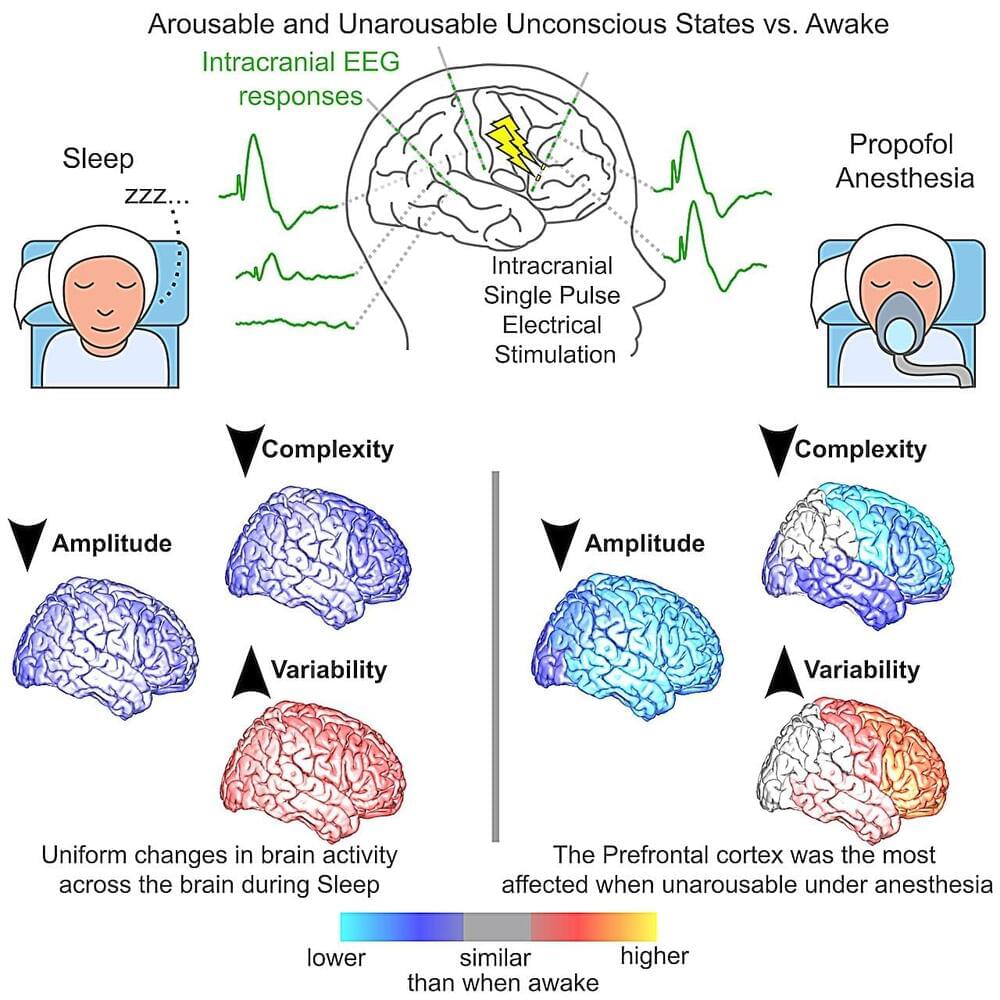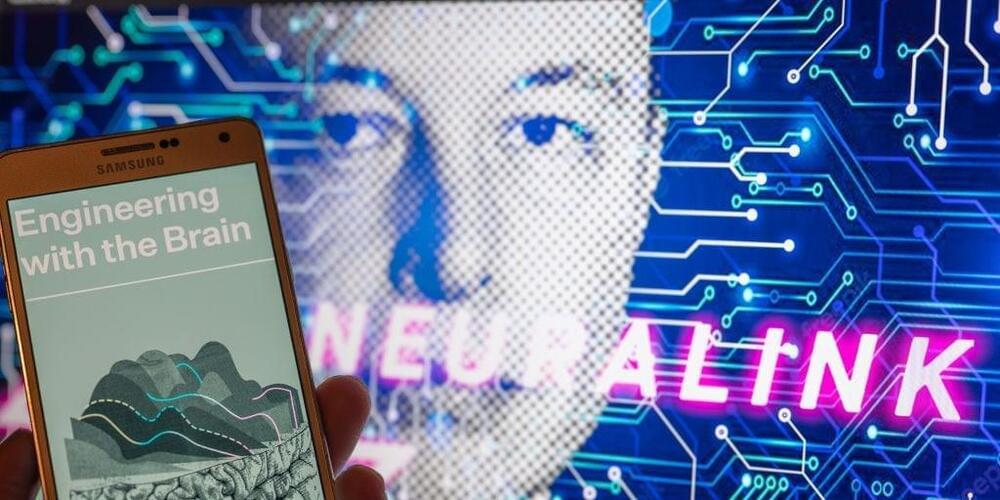To what degree do qualitative dendritic properties impact ANN-based neuron models’ ability to perform ML benchmark tasks.
Category: neuroscience – Page 485

Study unveils the engagement of different cortical networks while humans are unconscious
Despite substantial work, we are still unsure which brain regions are involved and how they are impacted when consciousness is disrupted.
States of unconsciousness, such as those that occur during sleep or while under the effect of anesthesia, have been the focus of countless past neuroscience studies. While these works have identified some brain regions that are active and inactive when humans are unconscious, the precise contribution of each of these regions to consciousness remains largely unclear.
Researchers at Massachusetts General Hospital recently carried out a study aimed at better understanding the activity of different regions of the cortex, the outer layer of the mammalian brain, during different states of unconsciousness, namely sleep and general anesthesia. Their paper, published in Neuron, identifies distinct cortical networks that are engaged during different states of unconsciousness.
“We have always been interested in trying to understand better how neuronal activity in the brain gives rise to consciousness,” Dr. Rina Zelmann, the lead researcher for the study, told Medical Xpress. “This is a huge and difficult question to answer. In this project, we started with seemingly simple questions, such as: What happens in the human brain when we are unconscious? And, what happens when we cannot be awakened?”


Nicholi (@nicholiscience)
I’m starting a new series on Tiktok based upon Neurogenesis! If you have Tiktok please consider watching the first episode for less than a $1.00 My tiktok link: https://www.tiktok.com/@nicholiscience?_t=8hhEJQ0GQBP&_r=1 Tiktok name: Nicholiscience.
Nicholi on TikTok | 74.7K Likes. 13.9K Followers. Neuroscience. Philosophy, Imagination, and coffee. Prochoice 🧠.Watch the latest video from Nicholi
Vinod Menon — Typical and atypical development of large-scale brain networks
Keynote lecture at Neuroinformatics 2016 in Reading, United Kingdom.
TRACK I — NORMAL DEVELOPMENT / COGNITION
Talk title: Typical and atypical development of large-scale brain networks.
Speaker: Vinod Menon, Stanford School of Medicine, USA
About INCF
The International Neuroinformatics Coordinating Facility (INCF) is an international non-profit organization devoted to advancing the field of neuroinformatics and global collaborative brain research. Learn more about INCF: www.incf.org
Brain network hubs: maps, molecules, and models
Nervous systems are complex networks, comprised of billions of neurons connected by trillions of synapses. These connections are subject to specific wiring rules that are thought to result from competitive selection pressures to minimise wiring costs and promote complex, adaptive function. While most connections in the brain are short-range, a smaller subset of metabolically costly projections extend over long distances to connect disparate anatomical areas. These long-range connections support integrated brain function and are concentrated between the most highly connected network elements; the hubs of the brain. Hub connectivity thus plays a vital role in determining how a given nervous system negotiates the trade-off between cost and value, and natural.
selection may favour connections that provide high functional benefit for low cost.
Consistent with this view, Professor Alex Fornito will present evidence.
that hub connectivity is under strong genetic control. He will show that the strength of connectivity between hubs in the human brain is more heritable than connectivity between other nodes, and that the genetic variants influencing hub connectivity overlaps with those implicated in mental illness and intelligence. He will also discuss the progress and challenges of developing generative models that evaluate the role of different cost-value trade-offs in driving complex brain topology.
Professor Fornito completed his Clinical Masters (Neuropsychology) and PhD in 2007 at The University of Melbourne before undertaking postdoctoral training at the University of Cambridge, UK. In 2013, he assumed his current position at the Turner Institute of Brain and Mental Health, where he is Head of the Brain Mapping and Modelling Theme, Co-Director of the Brain, Mind, and Society Research Hub, and a Sylvia and Charles Viertel Senior Medical Research Fellow.
Alex’s research concentrates on developing new imaging techniques for mapping human brain connectivity and applying these methods to shed light on brain function in health and disease.

AI-powered program fights homelessness in Los Angeles
In a bid to combat the ongoing homelessness crisis, Los Angeles County is using artificial intelligence (AI) to identify and support individuals at the highest risk of becoming homeless.
This pioneering pilot program analyzes data from seven county agencies, including medical visits, mental health care, substance abuse diagnoses, arrests, and public benefit sign-ups, to identify those most vulnerable to homelessness.
Dedicated case managers then reach out to these individuals, offering comprehensive support for four to six months, including access to $4,000 to $6,000 in aid to cover essential expenses like rent, utilities, and groceries. This assistance is designed to stabilize not only their housing but also their overall well-being.
How Memory Makes Us and Breaks Truth: The Rashomon Effect and the Science of How Memories Form and Falter in the Brain
It is already disorienting enough to accept that our attention only absorbs a fraction of the events and phenomena unfolding within and around us at any given moment. Now consider that our memory only retains a fraction of what we have attended to in moments past. In the act of recollection, we take these fragments of fragments and try to reconstruct from them a totality of a remembered reality, playing out in the theater of the mind — a stage on which, as neuroscientist Antonio Damasio has observed in his landmark work on consciousness, we often “use our minds not to discover facts, but to hide them.”
We do this on the personal level — out of such selective memory and by such exquisite exclusion, we compose the narrative that is the psychological pillar of our identity. We do it on the cultural level — what we call history is a collective selective memory that excludes far more of the past’s realities than it includes. Borges captured this with his characteristic poetic-philosophical precision when he observed that “we are our memory… that chimerical museum of shifting shapes, that pile of broken mirrors.” To be aware of memory’s chimera is to recognize the slippery, shape-shifting nature of even those truths we think we are grasping most firmly.
Nearly a century after Nietzsche admonished that what we call truth is https://www.themarginalian.org/2018/03/26/nietzsche-on-truth…ral-sense/ the great Japanese filmmaker Akira Kurosawa (March 23, 1910–September 6, 1998) created an exquisite cinematic metaphor for the slippery memory-mediated nature of truth in his 1950 film Rashomon, based on Ryunosuke Akutagawa’s short story “In a Grove” — a psychological-philosophical thriller about the murder of a samurai and its four witnesses, who each recount a radically different reality, each equally believable, thus undermining our most elemental trust in truth.
Weaponizing Brain Science: Neuroweapons — Part 2 of 2
https://www.hdiac.org/podcast/neuroweapons-part-2/
The second installment of this two-part podcast continues the conversation with Dr. Giordano on the implications of weaponizing brain science. In an article he wrote for HDIAC in 2016 titled ‘Battlescape Brain’, Dr. Giordano hinted at the possibility of a neuroweapons arms race that could follow from international surveillance. Dr. Giordano provides an updated look at these concerns in the context of today’s environment. He concludes by describing ethical frameworks that could regulate future policies for biotechnology as the world moves forward in this dynamic area.
Watch regular HDIAC webinars and video podcasts by subscribing:
Become a member of the Homeland Defense and Security Information Analysis Center: https://www.hdiac.org/register/
Visit: www.hdiac.org.
Follow: https://www.instagram.com/dod_hdiac/
Like: https://www.facebook.com/DoDHDIAC/
Tweet: https://twitter.com/DoD_HDIAC
Connect: https://www.linkedin.com/company/dodhdiac
HDIAC Podcast — Weaponizing Brain Science: Neuroweapons — Part 1 of 2
https://www.hdiac.org/podcast/neuroweapons-part-1/
In part one of this two-part podcast, HDIAC analyst Mara Kiernan interviews Dr. James Giordano, a Professor in the department of Neurology and Biochemistry at Georgetown University Medical Center. The discussion begins with Dr. Giordano defining neuroweapons and explaining their applied technologies. He provides insight into the manner in which international weapons conventions govern the use neuroweapons and discusses the threats presented by neuroweapons in today’s environment. Dr. Giordano goes on to review the need for continuous monitoring, including his views regarding challenges and potential solutions for effectively understanding global developments in neuroweapon technologies.
Watch regular HDIAC webinars and video podcasts by subscribing:
Become a member of the Homeland Defense and Security Information Analysis Center: https://www.hdiac.org/register/
Visit: www.hdiac.org.
Follow: https://www.instagram.com/dod_hdiac/
Like: https://www.facebook.com/DoDHDIAC/
Tweet: https://twitter.com/DoD_HDIAC
Connect: https://www.linkedin.com/company/dodhdiac